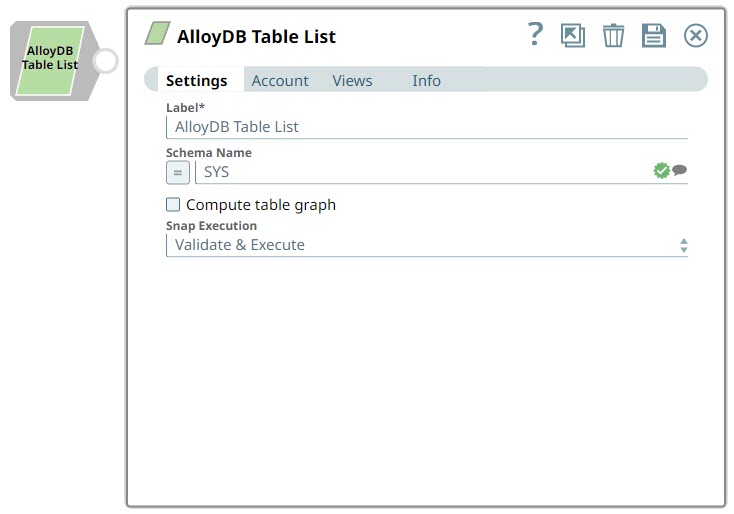AlloyDB Table List
Overview
You can use this Snap to list the tables in a database. This Snap connects to the database, reads its metadata, and outputs a document for each table found in the database. The table names display in topological order in the output so that tables with few dependencies display first in the output. For example, if table A has a foreign key reference to table B, then table B displays first in the output before A. The ordering is intended to ease the process of replicating a group of tables from one database to another.

Read-type Snap
Works in Ultra Tasks
Behavior changes
- The following are the behavior changes caused by the JDBC driver upgrade for PostgreSQL Snap Pack and Google AlloyDB Snap Pack .
- Some error messages will now include the data type for certain values, for example:
-
Old:
"...where (badId = 1) was aborted:..." -
New:
"...where (badId = ('1'::numeric)) was aborted:..."
-
- There are some minor text changes to a few of the error messages, for example:
-
Old:
"Hint: No operator matches the given name and argument types." -
New:
"Hint: No operator matches the given name and argument type(s)."
-
Snap views
| View | Description | Examples of upstream and downstream Snaps |
|---|---|---|
| Input | The schema name from where the Snap must list the tables. | |
| Output | This Snap outputs a list of tables in a database. Documents with a "name" field containing the fully-qualified name of the table and a "type" field. To use the table name in another Snap, like a Select or Insert, you can pass it through for each Snap to another Pipeline with the Select or Insert. | |
| Error |
Error handling is a generic way to handle errors without losing data or failing the Snap execution. You can handle the errors that the Snap might encounter when running the pipeline by choosing one of the following options from the When errors occur list under the Views tab. The available options are:
Learn more about Error handling in Pipelines. |
|
Snap settings
- Expression icon (
): Allows using pipeline parameters to set field values dynamically (if enabled). SnapLogic Expressions are not supported. If disabled, you can provide a static value.
- SnapGPT (
): Generates SnapLogic Expressions based on natural language using SnapGPT. Learn more.
- Suggestion icon (
): Populates a list of values dynamically based on your Snap configuration. You can select only one attribute at a time using the icon. Type into the field if it supports a comma-separated list of values.
- Upload
 : Uploads files. Learn more.
: Uploads files. Learn more.
| Field / Field set | Type | Description |
|---|---|---|
| Label | String | Required. Specify a unique name for the Snap. Modify this to be more appropriate, especially if more than one of the same Snaps is in the pipeline. Default value: AlloyDB Table List Example: List Tables |
| Schema name | String/Expression/ Suggestion | The database schema name. Selecting a schema filters the Table name list
to show only those tables within the selected schema. The property is suggestible
and will retrieve available database schemas during suggest values. Default value: N/A Example: test |
| Compute table graph | Checkbox | Computes the dependents among tables and returns each table with a list of
tables it has foreign key references to. The ordering of outputted tables is from
least dependent to most dependent. Note: Turning on this option will significantly
slow down the Snap; leave it as off unless you need it. Default status: Deselected |
| Snap execution | Dropdown list |
Choose one of the three modes in
which the Snap executes. Available options are:
Default value: Execute only Example: Validate & Execute |


